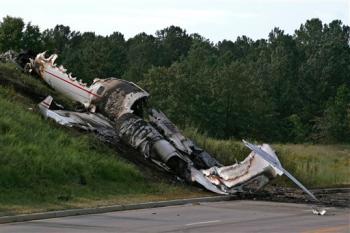Preliminary analysis of the right Pratt & Whitney Canada PW305A engine on a Learjet 60 that overran the runway at the Columbia Metropolitan airport in South Carolina the night of 19 September after attempting to abort its takeoff run indicates the engine was running at high power but its thrust reverser was stowed.
Killed in the accident were the pilot, copilot and two of the four passengers. The two survivors, popular musicians who had performed earlier at a concert, were seriously injured but are recovering.
According to witnesses, the Learjet, operated by California-based Global Exec Aviation, began a normal takeoff roll at 1153 in clear weather that night but sparks were observed as the airplane traveled down the 8,600ft (2,621m) runway on its way to Van Nuys. “At about 136kt, the crew attempted to reject the takeoff, however they were unable to stop the airplane before exiting the runway,” the NTSB writes in a new report released 22 October.
The aircraft’s cockpit voice recorder revealed that the crew initiated the rejected takeoff after hearing a “sound consistent with a tire failure” at 136kt, just after the V1 callout, the speed beyond which pilots are instructed to takeoff rather than attempt to stop on the runway.

The eight-passenger twin-jet continued past the 1,000ft runway safety area, hit airport lighting, navigation facilities, a perimeter fence and concrete marker posts before crossing a roadway and coming to rest on an embankment and burning. The aircraft was manufactured in January 2007 and had accumulated 120h flight time.
Investigators found the first piece of tire debris was found 2,300ft from the departure end of the runway, and prior to that, “five small pieces of broken taxiway reflector adhesive were found,” the report states. Roughly 150ft past the end of the pavement, the NTSB found the main landing gear pistons and wheel sets “with very little rubber other than tire beads” along with the brake assemblies.
Preliminary examination of the right side PW305A showed that the engine was operating at high power when it came to rest, which is consistent with expected reverse-thrust actions during a rejected takeoff. However investigators also found that the thrust reversers were in the retracted/stowed orientations, a finding that could explain why the aircraft did not stop on the runway.
Source: FlightGlobal.com
















